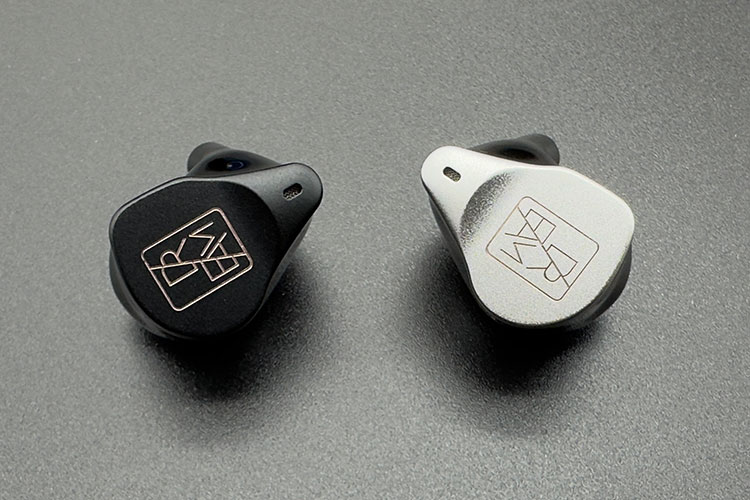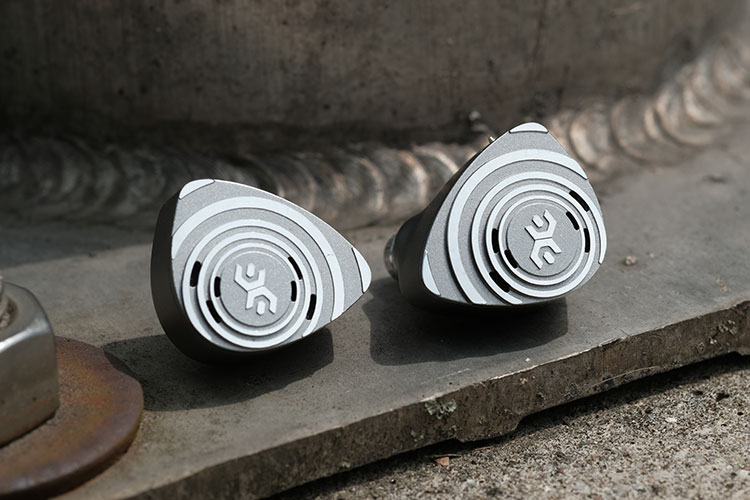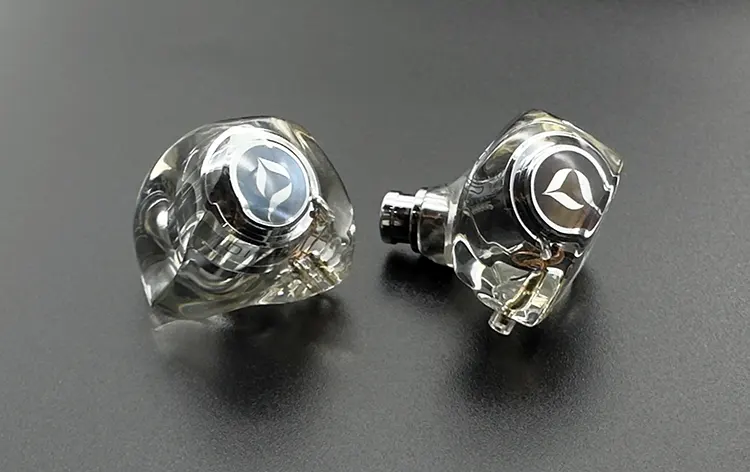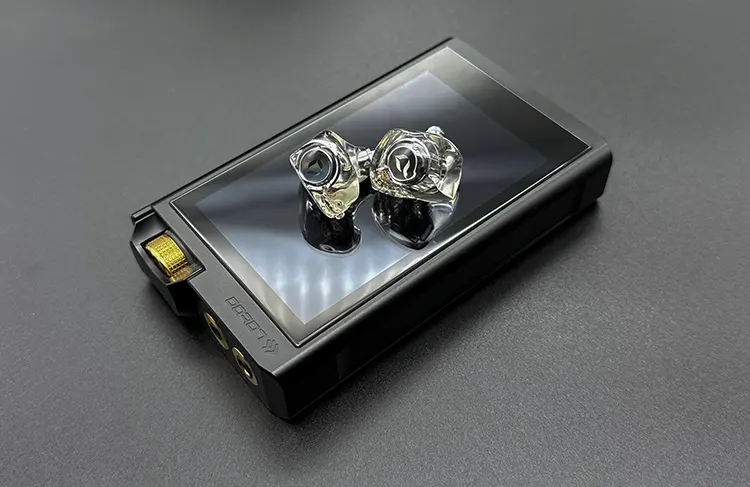Synergy
The SIMGOT EM10 has an impedance of 41.6Ω @ 1kHz and a sensitivity rating of 120 dB/Vrms. Though it is easy to drive the IEM, it does not shy away from demanding some extra power.
With better amplification, the EM10 has some improved staging and dynamics. However, I do not find the EM10 quite scalable, as beyond a point, the dynamics and coherency take some hit.
When used with the Lotoo Paw Gold Touch, the EM10 delivers a nice bass response and a richer midrange.
Given the decent power of this DAP, you’ll experience a significant improvement in audio quality compared to smartphones and dongles. I also played around with some inbuilt PMEQ settings and found that EM10 can take EQ quite well.
When pairing the EM10 with the Earmen Angel, a more powerful audio source, there are subtle improvements in dynamics.
The Angel introduces a touch of airiness to the upper frequencies and adds some transparency to the midrange. However, the bass is less prominent when compared to the Lotoo Paw Gold Touch, with the sub-bass losing some of its deep impact.
Select Comparisons
Elysian Acoustic Labs Pilgrim
Technical
The Pilgrim is a new hybrid from Elysian with a single 9.2mm dynamic driver and a triple BA driver configuration. The custom 9.2mm dynamic driver within the Pilgrim features Liquid Silicone Rubber (LSR) technology and a magnesium-aluminum alloy diaphragm.
For the mids and the highs, Elysian has equipped the Pilgrim with a custom-tuned Sonion BA driver for a refined presentation and a dual-tweeter E50 with a custom 3-way crossover threading all 4 drivers together.
The Pilgrim has a sensitivity of 101 dB/Vrms and an impedance of 9Ω @ 1 kHz. It does not need a lot of power and can be paired easily with a variety of sources, including smartphones and dongles.
Design
The shell of the Pilgrim is crafted from high-quality aluminum, while the bores are made from 304 stainless steel, well-known for its corrosion resistance. The shells are lightweight and quite durable.
The Pilgrim’s silver housings feature Knoll-inspired ridges that embellish the faceplate, drawing attention with their unique design. To add to the appearance is a combination of reflective and matte finishes, complemented by six vents surrounding an Elysian logo in the center.
In terms of appearance and design, the Pilgrim stands out with its sturdier metallic construction. Both IEMs exhibit decent-quality builds and are lightweight, although the Pilgrim’s shell is just a bit heavier.
The Pilgrim offers a choice between 3.5mm or 4.4mm termination options upon purchase, while the EM10 includes a modular cable. As for accessories, both IEMs are comparable. However, the overall presentation of the EM10 is superior.
Performance
The Pilgrim’s sound profile stands out for its clarity and transparency, with a subtle touch of warmth. Its sound is well-balanced across all frequency ranges, ensuring no element is overemphasized. The EM10 offers a much warmer tone. My preference for timbre still goes to the EM10.
In terms of bass performance, the Pilgrim delivers less quantity than the EM10, yet it excels in texture. The Pilgrim’s bass is well-controlled, offering a balanced mix of sub-bass and mid-bass.
While the EM10 boasts a more powerful sub-bass and mid-bass, I prefer the Pilgrim’s superior bass definition.
In the midrange, the Pilgrim shines with a more prominent, cleaner, and transparent presentation. It brings a decent amount of energy to the midrange, unlike the more laid-back midrange of the EM10.
The Pilgrim’s midrange is not only more forward but also has a slightly sweeter tone while the EM10’s heavier bass can sometimes overshadow the midrange details.
The Pilgrim’s treble is well-tuned, offering good energy and extension. In comparison, the EM10 falls slightly short in treble definition. While the EM10 does possess a respectable amount of energy in the lower treble range, the Pilgrim excels in extension.
The Pilgrim also provides more sparkle and airiness, though it can occasionally become sharp and sibilant. I find the treble on Pilgrim more coherent and well-aligned with the rest of the frequency range.
Both IEMs excel in their technical performance, delivering a high level of detail, though the EM10 stands out in this regard. The Pilgrim offers slightly superior resolution and more clarity.
While both IEMs have a similar soundstage width, the EM10 provides greater depth. Instrument layering is also marginally better on the EM10. Additionally, the EM10 surpasses the Pilgrim in imaging and spatial cues.
Dita Audio Project M
Technical
The Project M features DITA’s in-house customized PM1+ 9.8mm dynamic driver and a Knowles balanced armature driver.
Dita developed this dynamic driver specifically for Project M. Both the dynamic and BA drivers are housed in highly optimized stainless-steel chambers.
Project M has an impedance of 32Ω @ 1kHz and a sensitivity rating of 107 dB/Vrms so it can be easily driven by sources with less power including dongles and smartphones. However, Project M can scale well with more power.
Design
The shells of Project M are crafted from transparent 3D-printed resin, showcasing a solid and sturdy structure with a crystal-clear prism-like design that suggests durability and strength.
In terms of build quality, I find Project M more appealing and robust compared to EM10. The shells of EM10, on the other hand, are lighter. Project M offers a snug and comfortable fit, although they do protrude more from my ears compared to EM10.
The Project M connects with a 0.78mm 2-pin connector. As with the EM10, one gets a modular cable with multiple connectivity options of 4.4mm and 3.5mm. The cables on both the IEMs are equally good.
Project M impresses with its sophisticated presentation, clearly visible in its packaging. Deciding which of the two offers a superior unboxing experience is best left to the user.
The accessories bundled with Project M, like the Tanos carry case and Final Type E ear tips, surpass those provided with the EM10 in terms of quality.
Performance
Project M presents a near-neutral sound profile with a hint of warmth, contrasting sharply with the notably warmer EM10. I find the bass of Project M preferable to that of the EM10, as the former has a better-controlled bass.
Comparing them, the EM10 boasts greater quantity in both sub-bass and mid-bass. Meanwhile, Project M’s bass maintains a balanced, neutral character, distinct from the warm bass of the EM10. Project M’s bass is well-defined with superior texture, offering a quicker response compared to the EM10.
In the midrange, Project M distinguishes itself with a forward, cleaner, and transparent sound. It provides greater energy and clarity in this range. I particularly favor Project M’s rendering of vocals, especially female vocals, which sound natural and organic.
The forward-pushed midrange on Project M aligns perfectly with my preferences. In contrast, EM10 features a warmer midrange but lacks transparency.
The notes have more weight in comparison, however, the vocals and midrange instruments take a back seat in the overall presentation and are not quite forward and prominent.
The upper midrange on Project M might sound thin and sharp, creating a perception of enhanced resolution.
In the higher frequencies, Project M has increased energy and extended treble, however, it can come across as sharp and potentially fatiguing during extended use though I am sure it is a delight for treble enthusiasts.
On the other hand, EM10 displays more energy in the lower treble but lacks the same extension into the upper ranges.
Both of these IEMs showcase impressive technical qualities. The Project M offers a slightly wider soundstage, whereas the EM10 excels in perceived depth.
Notably, Project M delivers better resolution due to its transparent approach and reduced bass shelf compared to the EM10. Both IEMs excel at revealing micro details.
My Verdict
When SIMGOT announced the EM10, it generated a lot of excitement and anticipation within the community. Known primarily for their bright and energetic IEMs, the shift to a warmer, bass-heavy signature was unexpected, at least for me.
SIMGOT has quietly gathered user feedback and incorporated it into this new model, resulting in a sound signature that deviates significantly from its usual offerings. According to the brand, the EM10 underwent numerous revisions before reaching its final tuning.
So, what do I think of the EM10? I believe SIMGOT has done a nice job with its development. The EM10 successfully balances musicality and technical prowess, featuring a decent timbre and a fun, bass-heavy sound.
While there are areas for improvement that could have made this release exceptional, SIMGOT is on the right track. I am confident that with a few more releases, we will see something truly outstanding from them. Overall, the EM10 is a satisfactory release.
SIMGOT EM10 Specifications
- Driver Configurations: 1 DD + 8 BA + 1 PZT
- Frequency Response: 8Hz-40kHz
- Impedance: 41.6Ω ±15%
- Sensitivity: 120 dB/Vrms (at 1 kHz)
- Build: High-precision Resin 3D Printing
- Cable: Litz Structure High-Purity Oxygen-free Silver-plated Copper Wire
- 3.5mm Single-Ended / 4.4mm Balanced Interchangeable gold-plated Plug






